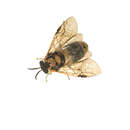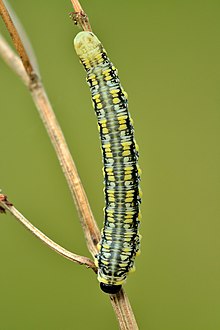fi
nimet breadcrumb-navigoinnissa


Diprion similis (auch als Zirben-Buschhornblattwespe bekannt) ist eine Art aus der Familie der Buschhornblattwespen (Diprionidae). Bekannt ist die Kiefernbuschhornblattwespenart in erster Linie als ein in Nordamerika eingeschleppter gefährlicher Forstschädling.
Die ausgewachsenen Pflanzenwespen erreichen eine Körpergröße von 7–8 mm. Sie sehen denen der Art Diprion pini zum Verwechseln ähnlich und können nur mittels Genitaluntersuchungen unterschieden werden.[1]
Ausgewachsene Larven von Diprion similis besitzen zwei schwarze Linien auf dem Rücken. An den Seiten befindet sich ein gelb-weiß-schwarzes Fleckenmuster. Der Kopf ist schwarz.
Das ursprüngliche Verbreitungsgebiet der Kiefernbuschhornblattwespenart liegt in Europa und Nordasien.[2][3][4] Im Jahr 1914 wurde die Art erstmals in Nordamerika nachgewiesen. Dort breitete sie sich in den Folgejahren aus. Im Jahr 1977 reichte das Verbreitungsgebiet an der Ostküste von Südostkanada bis nach North Carolina und nach Westen bis in die Region der Großen Seen.[4] Da die weiblichen Imagines schlechte Flieger sind, wird deren räumliche Ausbreitung mit dem Transport von Bäumen und Laub erklärt, infolgedessen die Eier und Larven an neue Standorte gelangten.[3]
Das Habitat von diprion similis bilden Kiefernwälder. Die ausgewachsenen Pflanzenwespen fliegen in Europa meist ab Ende April bzw. ab Mitte Juli in zwei Generationen.[1] In Asien ist es üblicherweise eine einzige, in Nordamerika kann es bis zu drei Generationen pro Jahr geben.[1]
Die Larven fressen Kiefernnadeln. In den USA vorrangig an der Weymouth-Kiefer (Pinus strobus) jedoch auch an anderen Kiefernarten wie Waldkiefer (Pinus sylvestris), Banks-Kiefer (Pinus banksiana) und Amerikanischer Rot-Kiefer (Pinus resinosa) sowie in geringerem Maße an Pinus virginiana und Pinus echinata.[2][4]
Die weiblichen Imagines legen ihre Eier in Kiefernnadeln ab. Dazu sägen sie mit ihrem Schneideapparat Schlitze in die Nadeln. Die Larven durchlaufen sechs Stadien und erreichen im letzten Larvenstadium eine Körperlänge von 25 mm. Die Afterraupen spinnen einen Kokon, den sie an Pflanzenteilen befestigen. Anschließend verpuppen sie sich im Kokon.[4]
Zu den Puppenparasitoiden von Diprion similis zählen folgende Erzwespen aus der Familie Torymidae:[5]
Weitere Larven-Puppen-Parasitoide sind folgende Raupenfliegen (Tachinidae):[5]
Aus der Literatur sind folgende Synonyme bekannt:
Diprion similis (auch als Zirben-Buschhornblattwespe bekannt) ist eine Art aus der Familie der Buschhornblattwespen (Diprionidae). Bekannt ist die Kiefernbuschhornblattwespenart in erster Linie als ein in Nordamerika eingeschleppter gefährlicher Forstschädling.
Diprion similis is a species of sawfly in the family Diprionidae. It is native to central and northern Europe and Asia but was accidentally introduced into North America where it has become invasive. The larvae feed on the needles of pine trees, especially those of the white pine (Pinus strobus). In North America it is known as the introduced pine sawfly or the imported pine sawfly. It is also known as the white pine sawfly because of its preference for feeding on the white pine, but this name is confusing because another sawfly, Neodiprion pinetum, whose larvae also feed on this tree, is itself known as the "white pine sawfly".
The adult male is between 7 and 9 mm (0.28 and 0.35 in) in length, black apart from the underside of the abdomen which is sometimes reddish-brown. Antennae are black and bipectinate (feather-like), and legs are yellow except for the trochanters and the base of the femora which are brownish-black. The female is between 7.5 and 10 mm (0.3 and 0.4 in) long, with a black head and thorax and usually a yellow and black abdomen, although some individuals are dark. Antennae are black and serrate (saw-like), and legs are yellow with dusky bases.[3]
Larvae have black heads and resemble the caterpillars of lepidopterans. Females have six instars and males have five. The first three instars are yellowish-green, and the later instars have black longitudinal stripes with patches of yellow and white on a bluish and black background.[3]
D. similis is native to central and northern Europe (including Fennoscandia), Russian Siberia (as far as the Lake Baikal region), and China. It was first detected in North America in 1914 in Connecticut and has since spread to much of the eastern United States and Canada, wherever Pinus strobus is to be found. It feeds on other species of pine, but seems to favour P. strobus where it is available.[3]
In its natural range, the larvae feed on several species of pine including Pinus sylvestris, Pinus mugo, Pinus cembra and Pinus sibirica as well as such introduced species as Pinus strobus and Pinus contorta. In North America, as well as Pinus strobus, it feeds on Pinus resinosa, Pinus banksiana and P. sylvestris.
Diprion similis is arrhenotokous, that is it exhibits a form of parthenogenesis in which unfertilized eggs develop into male offspring. Fertilised eggs develop in the normal way into male and female offspring, n = 14 for haploid males and 2n = 28 for diploid females.[3] Adults emerge in spring or later in the year and are active for most of the summer. The female makes a slit in a pine needle with her ovipositor and lays about ten eggs. Unmated females can lay viable eggs and these develop into male offspring. Newly hatched larvae are gregarious but later stages live independently. They feed on the needles of the pine until ready to pupate. The first generation spin cocoon in July and emerge in August. The second generation tends to drop to the ground and spend the winter in a cocoon as a prepupa, pupating in the spring. Some may remain in a prepupal state for a longer period of up to three years.[3]
Sawflies such as this species that have been introduced into North America have found little competition from native sawfly species and become invasive pests. They have few predators or parasites in the New World and their parthenogenetic abilities have allowed them to thrive.[4]
Sawflies employ pheromones to attract the opposite sex and facilitate breeding. It has been found that the pheromone emitted by D. similis contains the (2S,3R,7R)-propionate form of the isomer of 3,7-dimethylpentadecan-2-yl as its main component, while Neodiprion pinetum, which also feeds on white pines, uses the (2S,3S,7S)-acetate isomer as its main constituent.[5]
 Larva (top view)
Larva (top view) Diprion similis is a species of sawfly in the family Diprionidae. It is native to central and northern Europe and Asia but was accidentally introduced into North America where it has become invasive. The larvae feed on the needles of pine trees, especially those of the white pine (Pinus strobus). In North America it is known as the introduced pine sawfly or the imported pine sawfly. It is also known as the white pine sawfly because of its preference for feeding on the white pine, but this name is confusing because another sawfly, Neodiprion pinetum, whose larvae also feed on this tree, is itself known as the "white pine sawfly".
Diprion similis is een vliesvleugelig insect uit de familie van de dennenbladwespen (Diprionidae).[1] De wetenschappelijke naam van de soort is voor het eerst geldig gepubliceerd in 1836 door Hartig.
Bronnen, noten en/of referenties